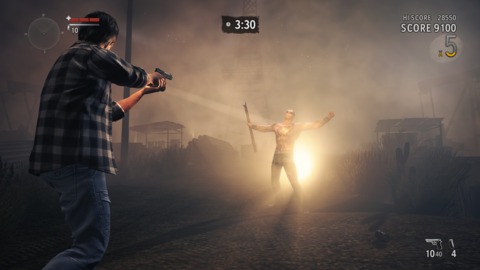
When the credits rolled on Alan Wake’s surprisingly excellent add-on The Writer, my first thought was not “more combat, please.” Combat in Alan Wake, a one-two punch of weakening enemies with a flashlight and pumping them full of lead, was fine but outstayed its welcome. More combat and a bit more story is exactly what Remedy Entertainment has delivered with Alan Wake’s American Nightmare, a downloadable expansion that, sadly, fumbles by stretching what little story it does have much too far.
There is no longer a big world for Alan Wake to run around in. Instead, American Nightmare limits players to three big-ish environments: a motel, observatory, and drive-in theater. While Alan does “drive” to each location, the player has no control over that part--it happens during loading screens. American Nightmare is a much more guided experience than Alan Wake, a result of the limited narrative scope.
If you’re interested in knowing what happened after Alan Wake, there are clues that paint a picture of recent events. This is not Alan Wake 2, however, and know that before going in. When the first location in American Nightmare wrapped up after about 30 minutes, it seemed my time in Night Springs would be awfully short, but then Remedy pulled a pretty clever narrative twist out of its hat. There is a reason for players to explore the game’s environments three times to bring about the story's ultimate conclusion.
On paper, it works. The narrative trick fits the weirdness of Alan Wake’s world, and the first time it happens, it’s actually pretty neat. The second time, it proved too much. Not enough substantively changes on subsequent trips to justify cycling through the three environments all over again. The game seems to acknowledge this issue by eventually spawning Alan much closer to objectives, preventing players from having to traverse the entire map all over again. You do spend less time in each location on follow-up visits, though, and some of the padding simply comes from whether or not you want to keep looking for TVs with FMV clips (do it) and manuscript pages. If you successfully journey through the night, however, you will be treated to several full-screen FMV sequences, nearly worth it on its own.
In order to collect everything, you'll have to search high and low on each trip around the block, as some manuscript pages are only available during rounds two and three. Fortunately, finding the pages is much easier in American Nightmare, thanks to a near-obnoxious increase in each page's sparkly nature, and a question mark that briefly appears on the mini-map, suggesting you should investigate.
It’s all too bad, really, because American Nightmare's story is fun, goofy and self-referential. For once, characters will immediately start challenging Alan about the absurdity of his situation, and while most end up coming around to believing and working with him, convincing them leads to some great dialogue. The way Remedy completely leans into the Night Springs conceit from the original game (Alan Wake’s version of The Twilight Zone) works wonderfully, complete with “Written by Alan Wake” credit in the opening cut-scene. The Rod Serling imitation is pitch-perfect--different but not too different.

Combat itself hasn’t changed very much in American Nightmare, except that you’ll never worry about running out of ammunition again. There are plentiful ammo drops, and catch-all refill stations scattered about. I was one of those weirdos who enjoyed the survivalist aspect of Alan Wake, though, and trying to fix Alan Wake’s combat issues by making ammo a non-issue is a poor solution. A couple of new creatures have been introduced to change things up. One enemy splits into weaker versions of itself several times over, another can transform into a flock of crows and will often surprise you from behind, and there’s a gargantuan dude lumbering about with a mean chainsaw. For some reason, there are also tiny spiders everywhere.
Once the mystery in American Nightmare is solved, what’s left is Arcade Mode, Alan Wake’s wave-based survival mode. Things play out exactly as you’d expect, with Alan dropped into various nighttime settings and forced to fend off wave after wave of shadowy creatures until dawn arrives 10 minutes later. Alan Wake’s flashlight combat has a pleasurable rhythm to it, but there’s not enough nuance to sustain interest over more than a few 10-minute sessions. Collecting manuscript pages unlocks different tiers of weapons, which provides an incentive to hop back into the story mode again, but if you already played through the story, that’s now four times venturing into the same three environments.
Expecting an experience as ambitious as Alan Wake in a downloadable release may have been unrealistic, but Remedy set expectations unreasonably high with The Writer, which was utterly fantastic and ambitious. American Nightmare contains just enough story to justify a download for players invested in the fiction, but if you’re new to Alan Wake, there are games with wave-based modes featuring superior combat, and buying a brand-new copy of Alan Wake wouldn’t set your wallet back very much.